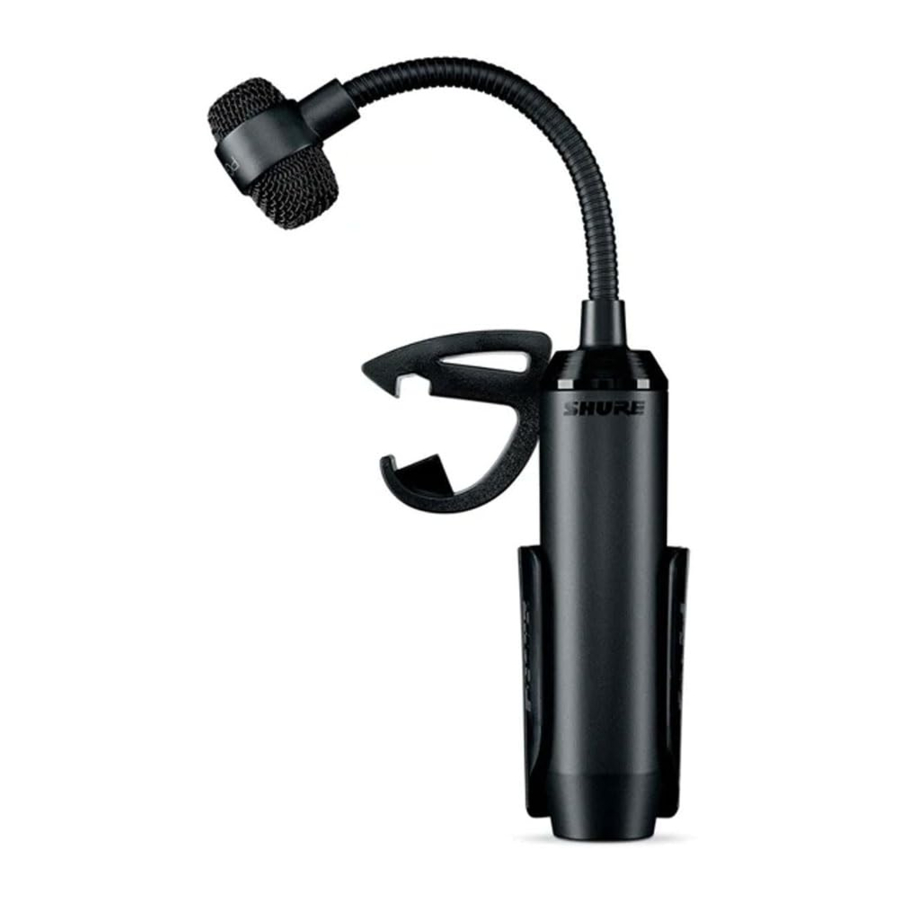
Shure PGA98D - Cardioid Condenser Drum Microphone Manual
- User manual (5 pages) ,
- User manual (8 pages) ,
- User manual (28 pages)
Advertisement

PG Alta Microphones
Congratulations on the purchase of a new Shure PG Alta series microphone. The PG Alta series delivers professional quality audio at an affordable price, with solutions for capturing nearly any source, including voice, acoustic instruments, drums, and amplified electric instruments. Suitable for live and studio applications, PG Alta microphones are built to last, and meet the same rigorous quality testing standards that make all Shure products trustworthy and reliable.
General Rules for Use
- Do not cover any part of the microphone grille with your hand, as this will adversely affect microphone performance.
- Aim the microphone toward the desired sound source (such as the talker, singer, or instrument) and away from unwanted sources.
- Place the microphone as close as practical to the desired sound source.
- Work close to the microphone for extra bass response.
- Use only one microphone to pick up a single sound source.
- For better gain before feedback, use fewer microphones.
- Keep the distance between microphones at least three times the distance from each microphone to its source ("three to one rule").
- Place microphones as far as possible from reflective surfaces.
- Add a windscreen when using the microphone outdoors.
- Avoid excessive handling to minimize pickup of mechanical noise and vibration.
Applications
The small, flexible design of the PGA98D microphone allows it to fit into tight spots around drums. The included drum microphone clip makes drum mounting fast and easy, but the microphone can also be used on other sources by mounting it in a standard clip.
Drums
- For more stick attack, aim the microphone towards the center of the drum head.
- To capture more resonance and overtones, aim the microphone towards the edge of the drum head.
- Positioning the microphone closer to the drum head delivers increased bass.
Other Instruments
The PGA98D can effectively capture other instruments where space is limited. Simply mount the microphone in a standard clip and adjust the gooseneck to aim it at the source.
Drum Microphone Mounting

To attach the microphone clip to a drum rim:
- Place the microphone clip with the groove seated securely over the top of the drum rim
- Position the bottom of the clip to wrap underneath the drum rim. The clip is flexible and can be gently bent to fit if necessary.
- Insert the microphone into the clip and adjust the gooseneck as necessary
Aiming the Microphone
Position the microphone with the arrow pointed at the sound source.

Front
Specifications
Type
Electret Condenser
Polar Pattern
Cardioid

Polar Pattern
Frequency Response
60 to 20,000 Hz

Frequency Response
Output Impedance
at 1 kHz, open circuit voltage
850 Ω
Sensitivity
at 1 kHz, open circuit voltage
- 52 dBV/Pa[1] (2.51 mV)
--
[1] 1 Pa=94 dB SPL
Maximum SPL
1 kHz at 1% THD, 1 kΩ load, typical
130 dB SPL
Self Noise
A-weighted, typical
27 dB SPL A
Polarity
Positive pressure on diaphragm produces positive voltage on pin 2 with respect to pin 3
Connector
Three-pin professional audio (XLR), male
Weight
210 g (0.5 lbs)
Housing
Cast Zinc
Power Requirements
11 to 52 V DC phantom power (2 mA)
Optional Accessories and Replacement Parts
| Foam windscreen for PGA98H and PGA98D microphones | AP98WS |
| Drum mounting clip for PGA98D | AP98DM |

Documents / Resources
References
Download manual
Here you can download full pdf version of manual, it may contain additional safety instructions, warranty information, FCC rules, etc.
Download Shure PGA98D - Cardioid Condenser Drum Microphone Manual
Advertisement




















Need help?
Do you have a question about the PGA98D and is the answer not in the manual?
Questions and answers